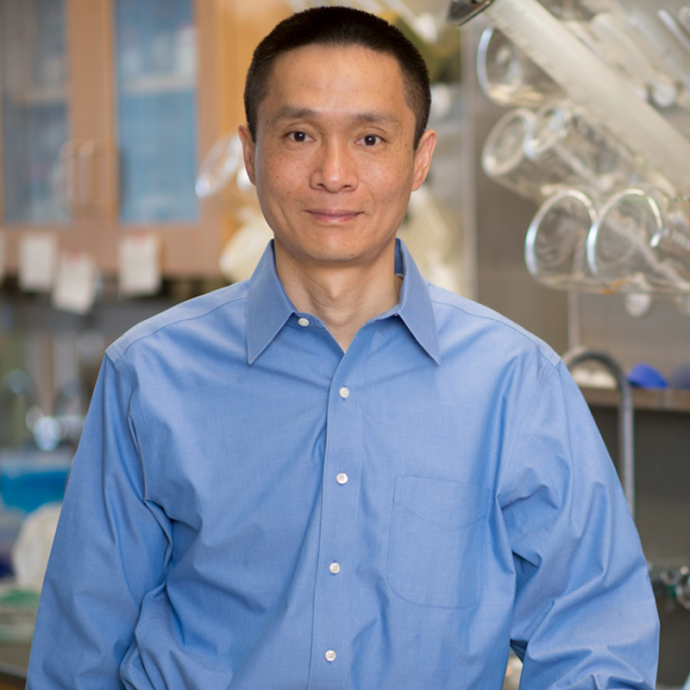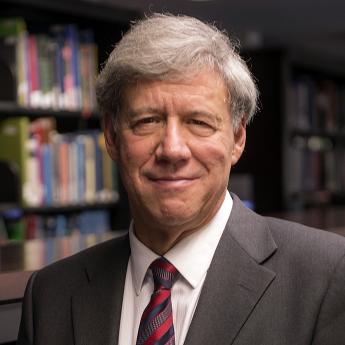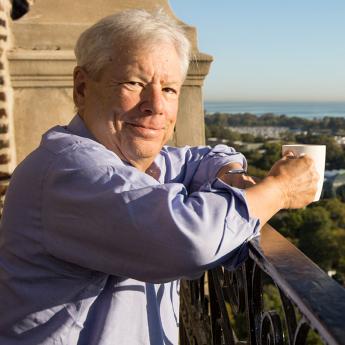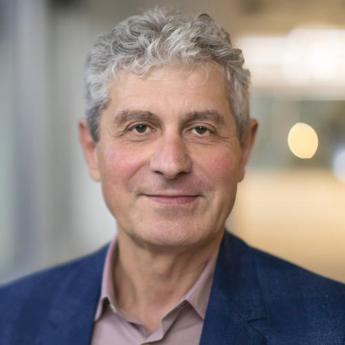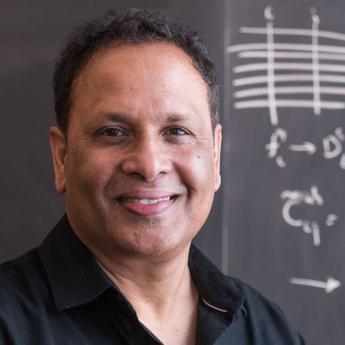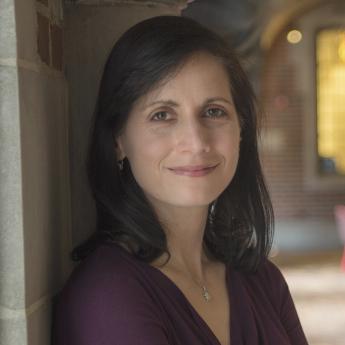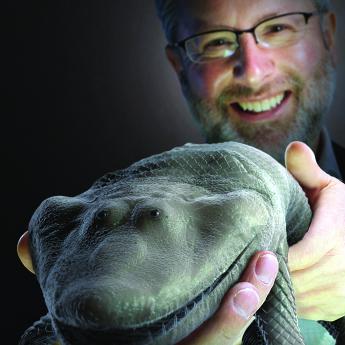Show Notes
By 2050 humanity is going to have to produce 50% more food in order to feed a growing population. That’s a lot, especially given that we currently have trouble feeding the current global population, and that food production is already responsible for about a third of the greenhouse gases that cause climate change.
But an incredible new genetic breakthrough may have just given us a way to address both those problems. Chuan He is a distinguished professor of chemistry at the University of Chicago, and he recently made a genetic discovery that has massive implications for feeding the world, addressing climate change and even fighting cancer.
Subscribe to Big Brains on Apple Podcasts, Stitcher and Spotify.
(Episode published August 5, 2021)
Related:
- RNA breakthrough creates crops that can grow 50% more potatoes, rice—UChicago News
- UChicago-Led Team Discovers Way to Dramatically Boost Crop Production—WTTW
- University of Chicago scientists find a new way to boost crop yields—Chicago Sun-Times
Transcript:
Paul Rand: Humanity is facing a ticking time bomb. It’s a staggering number, 9 billion, that’s the estimated world population in 2050, and perhaps most daunting here, how will we feed that many people?
Chuan He: By 2050, we’re going to need a 50% increase of food supply to sustain the population growth.
Paul Rand: 50% increase, that’s a lot, especially when we already have trouble feeding the world today and food production is responsible for about a third of the greenhouse gases that cause climate change.
Chuan He: Now, what we see in the world is we’re destroying rainforest or wetlands so we can grow more crops and other economic plants. This in turn contribution to global warming because we have less forest to soak more or fix more carbon dioxide.
Paul Rand: In the scientific community, there’s been a race against the clock to find a solution to this problem. That voice you’re hearing may just have found part of the answer.
Paul Rand: This is Chuan He, he’s a distinguished professor of chemistry at the University of Chicago. You may hear He’s name in connection with the Nobel Prize someday. And if you do, it will probably be because of his discoveries around something called RNA methylation. It’s this discovery that may hold part of the key to our food shortage problem.
Speaker 3: Almost a billion people around the world don’t have enough food to eat, that’s according to the United Nations World Food Programme, but in a potentially world-changing discovery, scientists led by a team from the University of Chicago have found a way to manipulate RNA to boost crop production by a lot.
Chuan He: This is something I personally could have never dreamed about when I started working on RNA methylation back over a decade ago.
Paul Rand: But the uses of RNA methylation don’t stop at food production. They could also lead to a new cure for cancer.
Chuan He: We have lots of unpublished data suggesting that RNA methylation is a critical way for our human system to sense and to cope with the presence of tumor.
Paul Rand: We work to make sure that every Big Brain episode has exciting breakthroughs and research, but the implications of He’s work are jaw dropping. It’s one of the rare moments when you see a possibility to use science, to tackle some of the biggest challenges that are facing our world.
Chuan He: Well, that’s the dream come true, right? I think as a scientist, our research is firstly driven by curiosity, but as every scientist will tell you, we also really want to see the social impacts of research. Not only just to satisfy our own curiosity, but also whatever we work on can better to the world.
Paul Rand: From the University of Chicago Podcast Network, this is Big Brains, a podcast about the pioneering research and pivotal breakthroughs that are reshaping our world. Today, the powerful secrets of RNA methylation. I’m your host, Paul Rand.
Paul Rand: Most of the work Chuan, that you have been doing, it has to do with RNA. I’m wondering if you can give some folks just a biology course background or on what RNA is since they may have forgotten it from their basic biology.
Chuan He: Yeah. If we think about our high school, general biology course in the central dogma, DNA is converted to RNA and RNA is converted to protein. So DNA is where all the genetic information is stored. Now, if we visualize this as a computer DNA would be the memory, stores all the information. Protein would be the hardware, that’s the one that functions and does all the work. And what’s RNA? It’s the software, it’s connects memory to the hardware.
Paul Rand: You’ve talked about some of the most important work in the well-known discovery has to do with something that’s called, if I’m pronouncing this word right, RNA methylation? You’ve said that this actually ushered in the modern era of RNA modification research. So I’m wondering if you can tell me what RNA methylation is and what did you mean by that quote?
Chuan He: Yeah. Well, unfortunately, that’s going to be a longer story because if we want to understand that, we’ll have to go back to central document. In human, remember we have something like tens of trillions of cells in the human. All these cells come from one fertilized egg. What that means is inside of you or me, our cells share almost identical DNA sequence. Yeah, we have 200 different tissue cell types, it’s mind-boggling the way we think about it, our skin cells versus our liver cells, our brain cells, they have exact same DNA sequence.
Paul Rand: Obviously, brain cells are very different from skin cells, but if their DNA is the same, how are they so different?
Chuan He: The difference is, it turns out, after the modification level, the DNAs, the proteins can be chemically modified. Now, what about RA? We asked them this question 2010 and in 2011, we showed indeed, the RNA muscle leaves a form of a chemical mark on RNA, can also have this broad deregulatory effect, just like the DNA and the histone modifications.
Paul Rand: There’s a lot of complicated science here, but it basically comes down to this. It turns out that RNA doesn’t just blindly deliver the blueprints that DNA gives it. RNA can actually regulate which part of that blueprint gets carried out or not. RNA methylation is basically the process of marking what those parts are going to be.
Chuan He: If you do not have RA methylation, most stem cells will stop differentiate. You won’t be able to get mature tissues. The embryonic stem cells will stop development.
Paul Rand: No RNA methylation, no difference between brain cells or skin cells.
Chuan He: It’s essential to human development. The second part of this each cell will need to communicate with other cells in the environment. It turns out that communication really rely on RNA methylation.
Paul Rand: Okay. So what does this have to do with food and cancer? Some of you may have put it together already. If you can go in and actually use the process of RNA methylation to control which parts of the blueprint get expressed, you can radically change living organisms.
Chuan He: So as I said, the hallmark of is essential roles for stem cells to differentiate into cells. Now, a hallmark of cancer is basically during human early development, cells differentiate, or grow, or proliferate rapidly. But once without form, we turn off those events. We don’t want rapid growth anymore. However, a mutation or an environmental factor somehow apparently turn on that switch that leads to development of tumor in many cases. Because RNA methylation is so critical to this normal development, it also critically impacts variety of tumor initiation and progression. The RNA methylation also is important to solve communication with other cells and the environment.
Chuan He: One system jump to mind is the immune system and in our 2018 paper we published in Nature was the first one, it’s actually really a tip of iceberg. We showed that RNA methylation is used by our immune cells to sense the presence of tumor and decide whether the immune system will eradicate the tumor or not. We have lots of unpublished data suggesting that RNA methylation is a critical way for our immune system to sense and to cope with the presence of tumor. So, we’re working on a variety of ways to modulate RNA methylation to turn our immune system, to get rid of tumors.
Paul Rand: So explain, what does that ... in your mind’s eye, what could that practically mean?
Chuan He: Right, right. So tumors are very smart. They figure all the ways to evade the immune response. One way that does is to surprise RNA methylation. So even though there’s a tumor, our immune, system’s supposed to get rid of it, but because of RNA methylation, our immune system ignore the presence of tumor so it can grow. So right now, we’re developing ways to switch off that RNA methylation system so tumor can be detected by the immune system and be eradicated.
Paul Rand: So, if we suppress the RNA methylation, the immune system can actually do its job and attack and even kill that tumor?
Chuan He: That’s right.
Paul Rand: Oh my goodness. So what does that actually practically mean? And what are the steps to getting to the point where you can say, ‘‘For your cancer treatment, we are going to change the course of treatment to do this.’’
Chuan He: That’s a great question. We have the IP, we licensed it to certain companies, in some cases, other cases that we’re still exploring.
Paul Rand: He is co-founder of a biotech company now developing new anticancer medicines based on targeting RNA modification proteins.
Chuan He: Currently, if you take immunotherapy, about 40% of melanoma patients with a response to immunotherapy, the other 60% that were not response. In other cancer, the responsive rate is even lower, a few percent to 10%. Lung cancer, breast cancer. So immunotherapy is great, but a lots of tumors, we say they’re cold so they don’t really respond to immunotherapy. We realize that RNA methylation is one reason to make them cold, so they don’t respond to immunotherapy. So in one direction we have been developing small molecule inhibitors, so the pills that you get from hospital, if you are a cancer patient, you can take this pills in combination with current immunotherapy. When we come with a small molecule to turn that switch, many of this tumor or cancer not responsive to immunotherapy become responsive to immunotherapy.
Chuan He: So, that’s one direction we’re currently working on. The second direction we’re currently what kinds is really to take human immune cells, engineer them, rewire their RNA methylation system so when they go to the tumor side, they’re not going to be suppressed by the tumor anymore. So they can directly attack the tumor. We’re developing small molecules that can target this And then hopefully these small molecules will go on clinical trials and eventually enter clinic.
Paul Rand: That’s just extraordinary. So by the time this could go into trials, could be when?
Chuan He: I’m hoping two, three years.
Paul Rand: After the break, a world changing solution to food scarcity and climate change, stay tuned. Hello, Big Brains listeners. The University of Chicago Podcast Network is excited to announce the launch of a new show. It’s called Entitled and it’s about human rights. Co-hosted by lawyers and UChicago Law School professors, Claudia Flores and Tom Ginsburg, Entitled explores the stories around why rights matter and what’s the matter with rights.
Paul Rand: There’s a global problem that has been keeping many scientists up at night. We need to produce 50% more food by 2050 to feed an ever-growing global population.
Chuan He: One complication is if we continue with the current trend, we’ll probably needs more land for producing food. That would mean we have less lands for forest and other ecosystems, that is a pretty significant problem.
Paul Rand: So if making more crops isn’t a solution. What if you could make better crops?
Chuan He: We realized that this interesting protein, FTO, play important roles in animal development. This protein works by remove methylation from RNA, so it takes the methylation off the RNA. If you don’t have this protein, the mice will grow a little smaller. So we started wonder what about plant? The plants have RNA methylation and we suspect RNA methylation also play important roles in normal plant development.
Paul Rand: So you are integrating animal FTO into plants. I mean, it’s kind of a crazy idea. What were you thinking might happen?
Chuan He: Well, in my lab, we love the weird ideas, that we don’t expect anything out of it. I guess 95% of the time my students will look at me and say, ‘‘You’re a idiot, it didn’t work,’’ but it’s that 5% of the time, you’re rewarded.
Paul Rand: Wow.
Chuan He: So, we started listening to rice and we had this, I would say jaw-dropping observation, that in lab, we actually see three-folds increase of rice yield. Later on, we tested in real fields that 50% increase of biomass rice yields and everything, but the results were just totally unexpected, I would say.
Paul Rand: So the plants grew 50% larger than they normally do, or they produce 50% more rice, or both?
Chuan He: Well, they have longer roots. They grow large number of roots and the longer routes. Then they have 50% of increase the biomass and proportionally, they have a 50% increase the yields. I want to say that that there’s a 50% increase to photosynthesis and increase to carbon dioxide fixation.
Paul Rand: And when you get the product, which is the rice, can you tell a difference between this product and more conventionally grown rice?
Chuan He: We analyzed everything, protein content, everything, they look identical. I don’t know if we cooked them and ate them or not, probably not because they’re trying to the seeds for the next round of experiments.
Paul Rand: Okay, interesting. So it’d be interesting. I’m assuming if they have all the same properties that it would taste the same.
Chuan He: I would think. I will go to taste them next time, I’ll make sure, I will let you know.
Paul Rand: Okay, good. I’m glad I could contribute to your experiments in a helpful way.
Chuan He: Yeah, that’s right.
Paul Rand: So now, you decided not to stop with rice. You thought, ‘‘That was interesting, but let me try potatoes.’’
Chuan He: Right, yeah. It’s a totally different type of plants. So here in this paper, we report rice and potatoes. In each case we saw 50% increase, but we didn’t stop there as well, we also tried other plants. We try the trees, we try the grass ad some other plants, almost all cases we saw this crazy gross phenotype.
Paul Rand: Can you just tell me what is happening inside these plants that is making them grow so much larger and be so much more productive?
Chuan He: That’s a great question, Paul. We currently do not know the exact mechanism, but there must be a inherent or intrinsic possibly in plants to tumor growth and now we somehow turned on that switch.
Paul Rand: So here’s the theory. Plants have a built-in system of using RNA methylation to tell their cells to stop growing if there’s drought or a reason to conserve energy. So, if you flip the switch on that built-in system, the plants take off.
Chuan He: If we go back to a central dogma again, sorry to bring this up again, again. So remembering central dogma, it’s DNA to RNA, RNA to protein. So somehow, the DNA to RNA step we dramatically elevated that step. We produce a lot more RNA out of DNA and that leads to plant to grow larger, deeper roots. It generate more tillers, more branch, and a lot more biomass.
Paul Rand: It doesn’t take a scientist to see the massive implications of this work, not only for 2050, but right now, people in developing countries go hungry every day due to a lack of food.
Chuan He: In developing world there’s still a lot of space to improve the efficiency and perhaps the yield of the crop grown there. The development of modern agriculture could perhaps make up of some of these gaps. Obviously, our discovery could contribute to that.
Paul Rand: But it goes beyond just making more food. Food scarcity can also occur due to increasingly extreme conditions, driven by climate change.
Tape: A mega drought in the west becoming a massive problem.
Tape: Now Madagascar is paying one of the highest prices for climate change which they have done little to cause. The toughest droughts in 40 years have left thousands on the island on the brink of starvation.
Tape: Guatemala now has one of the worst malnutrition rates in the world. This quiet crisis is being caused by climate change. The weather is now so variable, growing enough food has become all but impossible.
Paul Rand: But He’s plants may solve that problem too.
Chuan He: There are several benefits of these plants, way beyond the crops. Remember they have longer roots, they survive drought much better. So they can grow on their more extreme conditions.
Paul Rand: Because the roots go deeper.
Chuan He: The roots go deeper, so they survive better. Also the solidify soil, so they will prevent in principle, the spread of desert. Now keep in mind, not only food supply when we have this population growth, we also have higher demands, not only from food, but also stock materials. The woods, rubber, grass for cattle, et cetera, et cetera. All of these are connected to our Earth’s ecosystem. So these problems are connected. With global warming, it’s getting worse because with global warming, lots of places, there is a spread of deserts, dramatic reduction of wetlands, grasslands and forest. So this is a really a cycle that the getting us into a ... worse and worse. So it’s important to come up with a solution with plants that not only provides sufficient food, but also sufficient stock material from plants and the lastly, some sort of plants that can help us maintain our forest, wetlands, and grassland.
Paul Rand: Speaking of climate change, not only do He’s plants grow 50% more, they also increase their photosynthesis dramatically, which means more carbon removal from the atmosphere.
Chuan He: The benefit of increasing photosynthesis, so you fix a lot more carbon dioxide. So, you’ll fix more carbon, which is the building block for plants.
Paul Rand: Okay, but what about people who are concerned about genetically modified plants or GMOs? Isn’t this sort of like super GMOs?
Chuan He: Right now we use genetic modification to show the phenotype and we are working on and we have preliminary results to show that we do not need to genetically modify the plants. So there are two types of plant engineering out there. One is genetically modified plant, another is CRISPR gene editing of plants. The CRISPR gene editing is much better accepted. This is a really the third type. We’re editing epigenetics, but we’re not editing the gene itself, we’re editing the RNA. So the CRISPR system edits the DNA and we added the RNA level. Now, we will introduce the gene in, animal gene to edit RNA, but we know a system that we do not need to introduce or leave the gene there. So we have a system very similar to CRISPR editing. We can change the RNA methylation without introducing a gene, so it’s not genetically modified.
Chuan He: That system, most likely when we apply it to the real-world application, we’re going to use that system to avoid genetic modification. So what we work on is like intrinsic plant passageways and all we will do is to turn on the switch existing in the plant.
Paul Rand: It’s doubtful that a discovery like this will be kept in a box for too long. And He is excited to see if you’ll excuse the pun, the fruits of his labor.
Chuan He: Our hope is to show the world that this works and is really up to different laboratories, companies and other entities to take this technology forward and hopefully make the world better.
Paul Rand: If you’re getting a lot out of the important research shared on Big Brains, there’s another University of Chicago Podcast Network show you should check out, it’s called Not Another Politics Podcast. Not Another Politics Podcast provides a fresh perspective on the biggest political stories, not through opinions and anecdotes, but through rigorous scholarship, massive data sets and a deep knowledge of theory. If you want to understand the political science behind the political headlines, then listen to Not Another Politics Podcast, part of the University of Chicago Podcast Network.
Matt Hodapp: Big Brains is a production of the UChicago Podcast Network. If you like what you heard, please give us a review and a rating. The show is hosted by Paul M. Rand and produced by me, Matt Hodapp with assistance from Alyssa Eads. Thanks for listening.
Episode List
SCOTUS Nears Unimaginable Era with Geoffrey Stone (Ep. 8)
Legal scholar Geoffrey Stone discusses why we are on the verge of an unimaginable era for the Supreme Court, the forgotten history of Roe v. Wade and free expression on college campuses.
Economist’s Journey to the Nobel with Richard Thaler (Ep. 7)
Richard Thaler discusses how a bowl of cashews inspired his early research, how he missed a 4 a.m. Nobel wakeup call from Sweden, and what it was like to act in a movie alongside Selena Gomez.
Future of Energy Innovation with Michael Polsky (Ep. 6)
In this alumni edition of Big Brains, Michael Polsky discusses his early days in the energy field, his current project to build one of the largest wind farms in the world and why he believes in the power of innovation.
The Expanding Universe with Wendy Freedman (Ep. 5)
Prof. Wendy Freedman discusses her research on measuring the age of the universe, her leadership of the Giant Magellan Telescope and the search for life outside our solar system.
Nature’s Design Secrets with Rama Ranganathan (Ep. 4)
Prof. Rama Ranganathan shares his pioneering research on evolutionary physics, and explains why he believes biology is at a similar point today as engineering was two centuries ago during the Industrial Revolution.
Mind of a Virtuoso Composer with Augusta Read Thomas (Ep. 3)
Prof. Augusta Read Thomas gives a glimpse into the creative process of a world-class composer, discusses the state of classical music today and how she helps train the next generation of composers.
Myths of U.S. Health Care with Katherine Baicker (Ep. 2)
Prof. Katherine Baicker discusses research on the true costs and benefits of expanding health care, dispelling a number of myths, and provides insights into how to improve health care for all.
Discovering the Missing Link with Neil Shubin (Ep. 1)
Prof. Neil Shubin discusses his discovery of Tiktaalik roseae, the 375-million-year-old fossil that was a missing link between sea and land animals—and what it meant for the understanding of human evolution and how it has impacted the future of genetic research.
